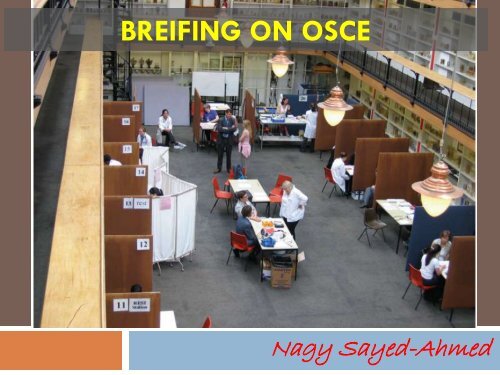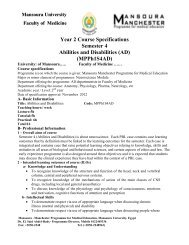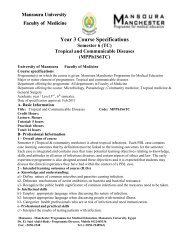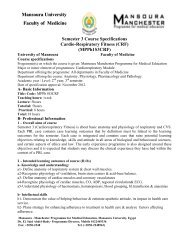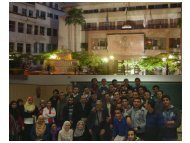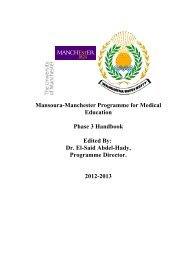BREIFING ON OSCE
Breifing Trainee on OSCE - Mansoura - Manchester programme
Breifing Trainee on OSCE - Mansoura - Manchester programme
- No tags were found...
Create successful ePaper yourself
Turn your PDF publications into a flip-book with our unique Google optimized e-Paper software.
<strong>BREIFING</strong> <strong>ON</strong> <strong>OSCE</strong><br />
Nagy Sayed-Ahmed
The Objectives of the programme<br />
Essential to the practice of medicine –<br />
Knowledge:<br />
Normal and abnormal structure and function<br />
Pathogenesis and epidemiology<br />
Presentation and diagnosis<br />
Prevention and management<br />
Skills:<br />
Clinical method<br />
Basic clinical procedures<br />
Attitudes and Competence needed to practice medicine<br />
as a pre-registration house officer
The Pillars of Education<br />
Knowledge<br />
Biomedical<br />
Contextual<br />
Intellectual<br />
Skills<br />
Communicative<br />
Procedural
Why to Examine?<br />
Assurance of competency<br />
Ranking students for competition<br />
for posts<br />
Educational impacts…..<br />
Others !!!!!!
Lecture<br />
Clinical<br />
Seminars<br />
Knowledge<br />
Understanding<br />
Essays, SEQs,<br />
MCQs, Viva<br />
Skills lab/<br />
Clin Training/<br />
others<br />
Skills<br />
Attitude<br />
Clinical,<br />
<strong>OSCE</strong>,<br />
OSPE, WPA
Education Process:<br />
What are you assessing?
Clinical Sems – Exams & Marks<br />
Item<br />
Midterm MCQs (2 or 3)<br />
SSC/Presentation & Active<br />
Attendence<br />
Final MCQs/EMQs<br />
Final <strong>OSCE</strong><br />
Final Short Essay<br />
Total<br />
Marks<br />
60<br />
70<br />
200<br />
200<br />
120<br />
650
Is it a valid examination?
Is it a reliable examination?
What educational impact will it have?
Is it feasible?
<strong>OSCE</strong>/OSPE - Format<br />
Observed Structured Clinical Examination / Objective Structured<br />
Practical Examination<br />
<br />
<br />
<br />
<br />
<br />
Different stations - each testing a specific clinical skill in a set time<br />
One examiner observes and assess each candidate at each station<br />
whilst remaining at the same station for the whole cycle<br />
Circuit- The passage of the candidates through the carousel of the<br />
number of stations<br />
Cycle is the number of times the examination is run on a give diet<br />
Candidates start the examination at a specific station, then progress<br />
through the other stations
WHAT IS AN <strong>OSCE</strong>?<br />
This is an assessment format in which the candidates<br />
rotate around a circuit of stations, at each of which<br />
specific tasks have to be performed, usually involving<br />
a clinical skill, such as<br />
History taking or<br />
examination of a patient<br />
Communication, Ethics & Attitude<br />
Data interpretation<br />
Preceedure perfection<br />
The marking scheme for each station is structured and<br />
determined in advance.
Advantages & disadvantages
Improving standards – 1<br />
Format<br />
•Structured interaction between examiner and candidate<br />
•Patients participating should have real physical signs<br />
•Patients relate their own history (may have some details<br />
modified to fit the scenario)<br />
•Surrogate or simulated patients - learnt the scenario and<br />
history to be discussed and related to the candidate<br />
•Surrogate patients - have no abnormal physical findings<br />
Format Examiners
Improving standards – 2<br />
Marking<br />
•The marking scheme for each station is<br />
structured<br />
•Weighting<br />
•Global vs. checklist scoring<br />
•Discussion of marking inconsistencies<br />
Examiners<br />
• Examiners must understand the principles of<br />
<strong>OSCE</strong>s
Practicalities of <strong>OSCE</strong><br />
• Suitable venue<br />
• Adjoining rooms<br />
• Big hall with partitions<br />
• Room for students to gather before exam<br />
• Room to brief examiners<br />
• Rest room for patients
Recruitment<br />
• Examiners<br />
• Patients<br />
• Simulated patients<br />
• Administrative support
DESIGNING A CLINICAL EXAMINATI<strong>ON</strong> SKILLS<br />
<strong>OSCE</strong> Station<br />
Consider the curriculum and assessment<br />
objectives<br />
Write instructions for site organisers<br />
Write instructions for examiners<br />
Write instructions for patients or volunteers<br />
Write marking criteria
Matching Curriculum to Assessment:<br />
Blueprinting
On the Day<br />
• Admin to supervise students waiting<br />
• Admin to check examiners all present<br />
• Admin to look after patients/SPs -<br />
?nurse<br />
• Helpers for ‘emergencies’<br />
• Timing system<br />
• Refreshments
Preparation<br />
• Decide running order for stations<br />
• Prepare order for students<br />
• Obtain equipment for each station<br />
• Produce mark sheets
C<strong>ON</strong>SIDER THE CURRICULUM /<br />
ASSESSMENT OBJECTIVES<br />
What are the index clinical situations relevant to<br />
this question?<br />
Which year group is this question designed for?<br />
Year 4<br />
Year 5<br />
Year 6
WRITE INFORMATI<strong>ON</strong> FOR SITE<br />
ORGANISERS<br />
<br />
<br />
What resources are needed?<br />
Real patient or healthy volunteer<br />
If real, full details of condition<br />
m or f or either?<br />
What age range is appropriate?<br />
Any other issues (eg ethnicity)?<br />
Any other resources needed for this station?<br />
Setting up the station<br />
Timing<br />
• 8 minutes<br />
Standard guidance (amend if needed)<br />
The couch should be positioned in such a way to allow the candidate to<br />
examine the ‘patient’ from the patient’s right side<br />
Facilities for handwashing/alcogel will be available
Station<br />
Number<br />
Code<br />
(admin. use<br />
only)<br />
Description<br />
Required logistics<br />
1 MHx History taking (1) Desk, 3 seats<br />
2 MExA Clinical Examination (1) Bed, 2 seats, bed sheet, hand cleaning gel<br />
3 MExB Clinical Examination (2) Bed, 2 seats, bed sheet, hand cleaning gel<br />
4 MD Data interpretation Desk, 2 seats<br />
5 SExA Clinical Examination (3) Bed, 2 seats, bed sheet, hand cleaning gel<br />
6 SPh Photographic material (1)<br />
Desk, 2 seats, PC or laptop (windows operated,<br />
MS office)<br />
7 SExB Clinical Examination (4) Bed, 2 seats, bed sheet, hand cleaning gel<br />
8 UHx History taking (2) Desk, 3 seats<br />
9 UPh Photographic material (2)<br />
Desk, 2 seats, PC or laptop (windows operated,<br />
MS office)<br />
10 UEx Clinical Examination (5) Bed, 2 seats, bed sheet, hand cleaning gel
WRITE INSTRUCTI<strong>ON</strong>S FOR STUDENT<br />
This is a 5 / 10 minute station, set in the<br />
[Specialty: ] outpatient department / ward<br />
/A&E / general practice.<br />
<br />
<br />
This is [insert name of ‘patient’<br />
Describe scenario if appropriate and task for<br />
student
WRITE INSTRUCTI<strong>ON</strong>S FOR PATIENT OR<br />
ROLE PLAYER<br />
Are there any instructions you need to<br />
give to the patient?<br />
eg what clothes to wear (and what<br />
needs to be removed), how to<br />
behave etc
Role play – Training & Briefing
DESIGN THE MARKING CRITERIA
Calibration<br />
<br />
<br />
<br />
<br />
<br />
<br />
<br />
<br />
Examiners must review and discuss the patients prior to the examination.<br />
This process, known as calibration, is essentially a standard setting<br />
process, and is critical to the fair and consistent conduct of the<br />
assessment.<br />
Examiners should ensure that the problem described in each of the<br />
scenarios is correct<br />
•Examiners should rehearse the history and check the physical signs<br />
•Examiners should agree which parts of the physical examination they<br />
feel the candidate should undertake<br />
•They should ensure that the patient or surrogate understands their role<br />
•The requirements to pass each of the skills should be agreed by the<br />
examiners.<br />
•If the station’s scenario is felt to be unworkable a the reserve scenario<br />
should be used.
What can go wrong?<br />
• Examiners late or absent<br />
• Patients ill or absent<br />
• Too hot room<br />
• Too much noise<br />
• Candidate getting distressed
Examiner Briefing for <strong>OSCE</strong>s
Thank you!<br />
• We appreciate your commitment<br />
in time and effort<br />
• Even if you have examined<br />
many times before, we would<br />
appreciate your attention for the<br />
next few minutes
The objectives of the <strong>OSCE</strong> – 1<br />
The main objective of most of the <strong>OSCE</strong> stations is<br />
to evaluate the students skills.<br />
Evaluate the students’ attitude, conduct, and<br />
behaviour<br />
Evaluate communication skills<br />
Evaluate performance skills in history taking and<br />
clinical examination<br />
Proper data extraction and interpretation
The objectives of the <strong>OSCE</strong> – 2<br />
Style of examination and/or ability to describe<br />
clinical findings or appreciated normality<br />
Ability of student to interpret and complement<br />
findings to reach proper diagnosis and/or<br />
management<br />
Manual skills in diagnostic and therapeutic<br />
maneuvers<br />
Evaluation of the depth of knowledge and<br />
information may be a 2ry but not a 1ry target
Check your station<br />
• If your station contains patients or<br />
simulated patients, check their story or<br />
signs with them before the students arrive<br />
• Do not alter the details of the simulated<br />
patient’s story or the marking scheme as<br />
this will impair standardisation across sites<br />
• If your station needs equipment, check it<br />
is all present and correct
How the station works<br />
• Students read the instructions outside the<br />
station<br />
• They have 60 seconds to read them<br />
• When they come in:<br />
– Confirm their identity<br />
– Let them start immediately<br />
– Do not delay them by reading the instructions<br />
again<br />
• Let them leave as soon as the bell goes
The mark sheet<br />
• These are comprehensively<br />
prepared<br />
• Fill in students’ names /numbers<br />
• Fill in your own name and examiner<br />
PIN number before the exam starts
The mark sheet<br />
There are 3 parts:<br />
• The ‘different sections’<br />
• The overall global mark<br />
• Written feedback<br />
All sections are equally important
Marking the different sections<br />
Based on your observation, decide how<br />
completely the student has performed each<br />
section<br />
Do not adjust for difficulty of station or the<br />
relative importance of each section; you are<br />
recording what you observe<br />
This information will be fed back to the<br />
students, so it is vital each row is completed<br />
Please use the full range of the marking<br />
scheme
Written feedback<br />
• There is a box at the bottom of the sheet<br />
for written comments (please be legible!)<br />
• This must be completed if you award a<br />
mark of
Marking fairly<br />
• The student should be unknown to you<br />
• If you do know them for any reason,<br />
please<br />
judge them on how they perform today<br />
• Do not be influenced by your previous<br />
knowledge of their skills (good or bad)
Marking fairly<br />
• Do not compare students with each<br />
other<br />
• Judge the student against the marking<br />
scheme<br />
• You are judging whether each student<br />
is competent<br />
• All could pass, all could fail at your<br />
station
Judge carefully<br />
• As a medical school, we are accountable<br />
for our assessments<br />
• By allowing a student to pass our<br />
examinations, we are confirming that he/she<br />
is competent to progress to the next stage of<br />
medical training<br />
• If you have doubts about a student’s<br />
competence, please help us and them by<br />
marking them as borderline or lower
You are not the final decision!<br />
• No student will fail because they have<br />
failed one station<br />
• It is their overall performance across<br />
the exam which counts<br />
• However, if you observe worrying<br />
behaviour, please make notes in the<br />
feedback box and speak to the Site<br />
Exam Lead after the exam
What we expect of you<br />
Do<br />
• Treat candidates<br />
politely and<br />
pleasantly<br />
• Treat candidates<br />
fairly and without<br />
any discrimination<br />
• Let them start and<br />
finish on time<br />
Don’t<br />
• Turn it into a<br />
teaching session<br />
• Give candidates<br />
verbal feedback as<br />
to how they are<br />
doing (good/bad)<br />
• Let them see your<br />
marks
Thank you!<br />
We welcome suggestions for<br />
improving the <strong>OSCE</strong>s further
5<br />
4<br />
3<br />
2<br />
1<br />
start<br />
10<br />
9<br />
8<br />
7<br />
6<br />
END
10<br />
9<br />
8<br />
7<br />
6<br />
5<br />
4<br />
3<br />
2<br />
1
1<br />
2 3<br />
4<br />
5<br />
Circuit<br />
Manager<br />
1<br />
0<br />
9<br />
8<br />
7<br />
Resting<br />
Station<br />
6
And more importantly


